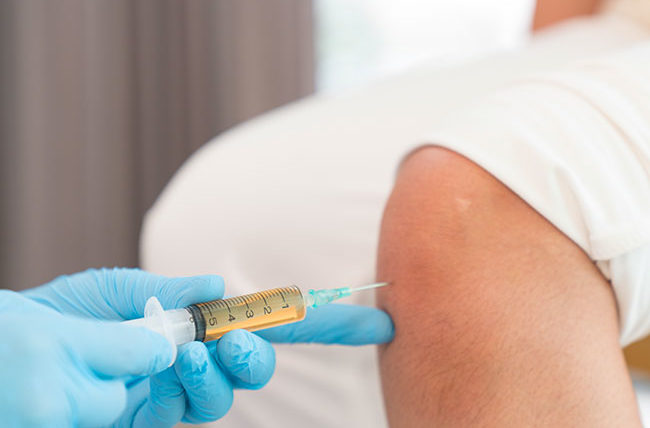Diabetes: Experimental drug may help restore insulin-producing cells

According to the World Health Organization, there are around 422 million people with diabetes globally, with some researchers estimating that the figure will reach 700 million by 2045. In the United States, approximately 1 in 10 people had diabetes in 2018, which makes diabetes the nation’s seventh leading cause of death.
There are two major types of diabetes:
- Type 1 (formerly known as insulin-dependent or juvenile diabetes) – The body does not produce the hormone insulin or makes very little of it. This form of diabetes is more common in children and young adults.
- Type 2 (formerly known as adult-onset diabetes) – The body does not produce enough or cannot properly use insulin. It is the most common form of diabetes (90–95% of all cases) and often begins later in life.
Insulin-producing beta-cells typically make up 50-70% of pancreatic islets (groups of cells in the pancreas). In both types of diabetes, there is a significant reduction in beta-cells primarily due to autoimmune destruction.
Individuals with Type 1 diabetes, and some people with Type 2 diabetes, must take insulin injections daily to survive. The alternative is whole pancreas or pancreatic islet transplantation, which is limited by the shortage of organ donors and the associated side effects of immunosuppressants.
Research into the regeneration of insulin-producing beta-cells could lead to developing a new therapy for individuals who rely on insulin injections.
In a recent study, the human epigenetics team at Monash University in Melbourne, Australia, found that the investigational drug GSK-126 can potentially restore insulin-producing beta-cells in Type 1 diabetes patients by inhibiting pancreatic EZH2.
Restoring insulin production
The EZH2 enzyme inhibits genes responsible for the development of insulin-producing beta-cells. The researchers hypothesized that blocking EZH2 activity may restore insulin production.
The researchers examined the effect of the highly selective EZH2 inhibitor GSK-126 on specific genes related to insulin production using ex vivo human pancreatic tissues from three donors, two non-diabetic and one Type 1 diabetes donor.
When the researchers analyzed the pancreas from the Type 1 diabetes donor, as expected, they noted absolute beta-cell destruction. The genes that regulate beta-cell development and insulin production in these pancreatic cells were “silenced.”
The researchers found that stimulating the pancreatic cells with GSK-126 could restore the hallmark genes responsible for developing pancreatic progenitor cells (stem cell-like cells) into insulin-producing beta-cells.
The researchers observed that GSK-126 also restored expression of the insulin gene in the cells taken from the Type 1 diabetes donor, despite absolute beta-cell destruction. The study is the first reported example of restored insulin gene transcription and provides strong evidence for beta-cell regeneration.
Potential new treatment for diabetes
Professor Sam El-Osta, Ph.D., Head of the Epigenetics in Human Health and Disease Laboratory at Monash University and lead study author, described this method of restoring insulin production as “rapid and cost-effective.”
“Our preliminary studies show vital insulin expression as early as 2 days of drug treatment when compared to 3 to 4 months with alternative approaches using human embryonic stem cells,” Dr. El-Osta told MNT.
By avoiding the use of embryonic stem cells, the study authors also avoided the ethical concerns that are commonly associated with such techniques. Another advantage of this potential diabetes treatment is that it is “less vulnerable to the risks associated with organ or islet transplantation,” he added.
Limitations and future research
Commenting on the limitations of their study, the researchers noted that they used cells from a single Type 1 diabetes donor. Additional studies are required to determine if the approach is successful in a broader Type 1 diabetes population.
Autoimmune attacks on insulin-producing beta-cells also present another hurdle to developing a new therapy, according to Dr. Matthias von Herrath, professor and founder of the Type 1 Diabetes Center at La Jolla Institute for Immunology in the U.S.
“In type 1 diabetes (and some cases of type 2 diabetes) there is quite strong (auto)immune reactivity to the islets and insulin-producing beta cells, [which] will not be avoided by making more of them. Thus, while an interesting progress, we would still have to deal with reducing this autoimmune reaction (ideally without systemically immunosuppressing the patients), which is not an easy feat.” Dr. Von Herrath said.
While this potential new diabetes treatment offers hope to individuals with Type 1 diabetes, it is “not ideally targeted” to Type 2 diabetes, according to Dr. John Buse, Ph.D., Director of the Diabetes Center at the University of North Carolina. “In the more common [T]ype 2 diabetes, the biggest problem is generally that insulin does not work very well,” Dr. Buse said.
When asked how soon this treatment option may become available to the public, Dr. Buse said, “With great focus, funding, and luck, a human drug treatment based on any early demonstration of benefit like in this paper generally takes 7-10 years. And in this case, the path to drug development is complicated by the need to get cells out of the body and into the lab and then back into the patient.”
